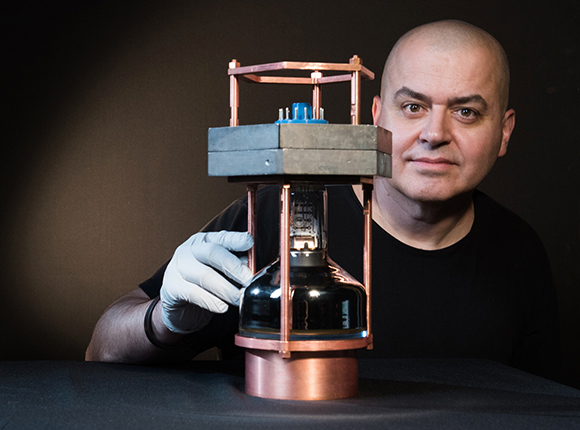Neutrino detection goes small
DOI: 10.1063/PT.3.3720
The traditional recipe for neutrino detection calls for a very large detector to compensate for the neutral particles’ extraordinarily meager rate of interaction. Yet theory has long offered a means of spotting neutrinos in a much smaller volume. In 1974 Daniel Freedman proposed measuring a low-energy neutrino’s interaction with an entire atomic nucleus. The probability that a neutrino would exchange a Z boson with a nucleus and in the process provide a subtle kick would roughly scale with the square of the nucleus’s neutron count. But there was a catch: The heavy nuclei that would maximize the interaction rate would also barely budge when struck by a feeble neutrino, so their recoil would be difficult to spot.
Researchers with the COHERENT collaboration have now overcome that challenge and measured the neutrino-induced recoils of nuclei in a 15 kg detector, a prototype of which is shown in the photo. They placed their experiment in a basement corridor just below Oak Ridge National Laboratory’s Spallation Neutron Source. The facility generates plentiful neutrinos as a byproduct of its neutron production, and it does so in regular pulses that facilitate isolation of background events. In addition, an intervening layer of concrete and gravel prevents neutrons and cosmic rays from reaching the detector, which is made of a transparent, scintillating crystal of sodium-doped cesium iodide. The crystal’s nuclei are neutron-rich enough to encourage neutrino interactions but lightweight enough for their recoil to generate measurable photons.

JEAN LACHAT/UNIVERSITY OF CHICAGO

After collecting more than 300 days’ worth of data with the neutron beam on and 150 days’ worth with it off, the COHERENT team detected between 112 and 156 events consistent with the elastic scattering of a neutrino off a cesium or iodine nucleus. The results favor the presence of neutrino–nucleus scattering at a 6.7-σ level. The researchers say that future detectors sensitive to the process could monitor nuclear reactors and provide improved constraints on interactions between neutrinos and quarks. Such understanding could prove useful in astrophysics, since some scientists have proposed that neutrino–nucleus scattering may play a role in the explosion of supernovae. (D. Akimov et al., Science, 357, 1123, (2017), doi:10.1126/science.aao0990
More about the Authors
Andrew Grant. agrant@aip.org
